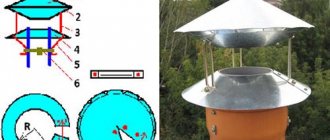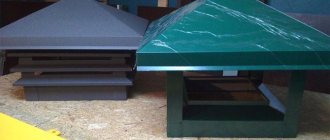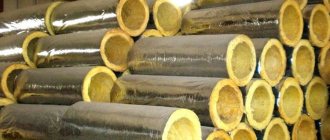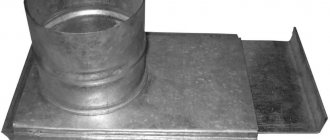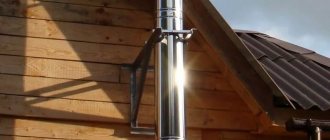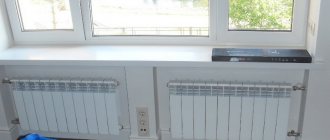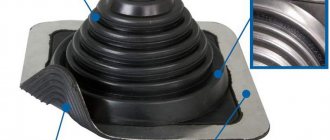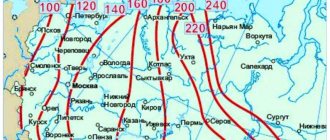Good afternoon, dear reader! To vent the mixture of gas and fuel combustion products outside, stoves, fireplaces and boilers must be equipped with smoke exhaust ducts. Their head is covered with a special visor or umbrella. At first glance, these products seem to be only decorative elements. But in fact, the cap on the chimney pipe performs a very important function in the chimney system. It can significantly increase the energy efficiency of the heating system as a whole, and also eliminate any risk of smoke in the home.
Cap device
The classic cap model is assembled from several parts:
- protective umbrella - in the shape of a pyramid, cone, mushroom, hemisphere or other, more complex configuration. It performs the function of protecting the pipe from moisture and foreign objects;
- apron - drip. This part of the cap serves to protect the head of the chimney from drops flying from the umbrella. It helps to increase the service life of the chimney, prevents the destruction of brickwork, corrosion of metal parts, the appearance of dampness and fungal deposits on the surface of the pipes;
- brackets - metal plates used to connect the canopy to the apron. Their number is selected depending on the size of the chimney and the weight of the umbrella. The welding method is used to fasten products.
Gable model
To make a gable weather vane, you need to use a machine called a sheet bender.
Just as in the previous case, first measure the outer surface of the brick chimney. Calculate the pattern and make the corresponding diagram. Next, the cap is assembled using a simple algorithm.
You need to cut the metal and bend it following the dashed lines. The resulting parts must be connected with rivets. The function of rigid racks is performed by ready-made corners made of painted metal , the thickness of which varies from 0.5 to 0.7 mm.
Principle of operation
Installing a cap on the chimney will not only protect against water and debris getting into the chimney pipe, but also allows you to optimize the draft in the heating device. This happens as follows:
- the air flow rests against the wall of the upper cylinder and is forced to go around it from all sides;
- sliding along the surface of the cylinder, the air stream turns upward, at this time the smoke coming out of the channel is sucked in;
- the air movement inside the chimney becomes more intense, a zone with reduced pressure is created at the top of the chimney, where smoke from the combustion chamber rushes;
- if the wind jets are directed vertically or at an angle, they penetrate into the upper cylinder through the gap and suck gaseous combustion products into the pipe.
Why do pipes smoke?
- Wrong
pipe diameter is selected.
- Incorrect pipe length as well as height.
- If the wind increases, cold air enters the chimney. The draft becomes less as wind pressure acts on the smoke, the smoke stops leaving the chimney and, as a result, the smoke remains in the chimney.
- The chimney is clogged with soot. You cannot use any chemicals when cleaning the chimney; to clean the chimney, you must invite a specialist.
- Perhaps a brick fell from the masonry. When strong winds rise, there are cases when bricks fall from the masonry. It is necessary to remove the brick and seal the hole with clay.
- The masonry begins to crack and cold air gets into the cracks, the draft decreases, and the fireplace will smoke. All cracks must be sealed with clay mortar.
- Condensation is released, causing the oven to become damp . Reason: when the temperature of the gases released during fuel combustion decreases. Due to the soot that accumulates on the pipe walls, it reduces the thermal insulation.
- If the chimney was built incorrectly.
- If the walls of the chimney are uneven and the cross-section of the chimney is small.
- If the chimney is installed below the roof.
- When installing a chimney near tall trees and houses.
- If the chimney passes air through the brickwork.
- If the room is poorly ventilated.
- Rain, snow.
- When it's warmer outside than in the building.
- When you light it for the first time when the chimney is frozen.
Advantages and disadvantages
The advantage of installing a cap on the chimney is:
- more aesthetic appearance of the chimney duct;
- protection of the internal space of pipes from foreign objects and various debris;
- protection of the chimney material from the effects of precipitation;
- the chimney covers part of the mouth, preventing the wind from overturning the draft.
There are not many disadvantages to installing an umbrella on a chimney, but they are quite significant:
- the product is installed in the path of combustion products exiting and serves as some obstacle to their free outflow. An incorrectly selected and installed model can reduce draft and lead to smoke in the room;
- The water vapor generated during fuel combustion exits along with the smoke through the pipe to the street and condenses, coming into contact with the cold metal of the cap, and then freezes when the temperature drops below 0º. As a result, icicles freeze on the chimney, blocking the passage opening of the pipe and preventing the smoke removal process.
Why install a chimney on a pipe?
This design is applicable not only to chimneys.
As a rule, chimneys are installed on the pipes of ventilation outlets and flues. In appearance, they look like a kind of canopy over the chimney. There are many options for designing chimneys; in the overall design, they look attractive and aesthetically pleasing, so those who are not familiar with the intricacies of construction work may think that this is an exclusively decorative detail. In fact, the beautiful appearance of the chimney is far from its most important characteristic.
Installation diagram of the chimney on the pipe (sectional view)
In addition to the fact that the cap on the chimney pipe protects it from precipitation and debris getting inside, it also prevents premature destruction of the upper part of the pipe. This quality is especially important if you need to protect a brick pipe.
The important functional load and attractive appearance of the roof make the chimney cap an indispensable element when installing a chimney.
Materials for making chimneys
When choosing a chimney for a pipe, you should pay attention, first of all, not to the appearance, but to the functionality that is provided by the material used to make the structure.
- Copper. It is considered the most functional material, as it can provide both attractive appearance and excellent performance. A cap for a chimney pipe made of this material, provided that the installation work is carried out correctly, will last for many years, never ceasing to please the owners of the house. Over time, the copper umbrella becomes covered with patina and becomes similar to antique products. When installing a copper umbrella, you should remember that this material, when interacting with other metals, begins to actively oxidize. This process can damage the structure ahead of schedule. To avoid such problems, when installing the chimney, it is necessary to use parts made of copper or containing copper for fastening.
- Steel. A chimney cap made of steel is less durable than a copper one. But their cost is an order of magnitude lower. With proper installation and selection of fasteners, steel chimney caps will last 10-15 years, and a stainless steel umbrella will last about 30 years.
- Zinc-titanium. This material is often used in roofing and installation work, since its technical characteristics are similar to copper. Chimneys on zinc-titanium pipes can be used without loss of performance for up to 50 years. The main condition for a long service life is to install the structure correctly.
If firewood is used as fuel in a home stove or bathhouse, then chimney smokers are not made of painted metal, since under the influence of high temperatures the paint layer will quickly burn out and the umbrella itself will become covered with soot.
Copper chimney for brick chimney
If the height of such a pipe does not exceed 5 meters, then it is best to make a canopy for the chimney pipe or a deflector from heat-resistant materials - copper or stainless steel. Since these metals are resistant to oxidation and corrosion, chimney caps will last much longer.
Design Features
The simplest design of the umbrella looks like a flat or cone-shaped cover installed at the top of the pipe. Modern technical capabilities make it possible to make this chimney element in a wide variety of shapes, some of which can be compared to a real work of art, such as a forged umbrella.
Many owners prefer to install a deflector, which increases draft in the chimney.
Depending on the architectural shape of the house, you can make an original umbrella with your own hands or buy a ready-made one. So, for houses in the “modern” style, it would be most appropriate to choose chimneys on pipes with a flat roof. A house in the European style will be perfectly decorated with a chimney cap in the form of a hemisphere.
This is what an installed chimney looks like on a pipe with protective decorative grilles
Chimneys are often installed that have several slopes on their roof: in winter, snow and ice do not accumulate on them, and the shape of the lid ensures good ventilation of the chimney.
For houses in which stoves or fireplaces are heated with wood or peat, and the roof is made of flammable materials, an umbrella with a spark arrester is installed.
This part is a stainless mesh with small cells, mounted on a metal frame.
You can make a spark arrester yourself and install it either in the chimney shaft or along the perimeter of the canopy.
Chimney cap with weather vane decoration
For all-round protection from blowing winds, one of the types of chimneys is used - a deflector.
Gusts of wind significantly reduce the draft in the chimney if its head does not have such a device. The deflector operates on the principle of aerodynamics, changing the direction of wind movement.
Structurally, the deflector consists of two cylinders: an upper one (in the form of a truncated cone) and a lower one, and a protective cap. Depending on the direction of the wind, the smoke comes out into one of two channels - upper or lower. The deflector is made of galvanized steel.
Types and designs of caps
The variety of shapes and types of smoke exhaust ducts forces manufacturers to develop hoods of any size, configuration, and appearance. In specialized stores you can buy a chimney of the following shapes:
- gable;
- hip;
- tent;
- spire-shaped;
- with a flat lid.
Photos of different types of chimney caps:
For the manufacture of caps, one of the following materials is used:
- stainless steel;
- copper alloy;
- roofing galvanized sheet;
- galvanized steel with powder coating;
- titanium and zinc alloy.
The chimney design may have:
- an opening lid, which greatly simplifies chimney maintenance;
- ventilation hole providing free exit for combustion products;
- spark arrester - designed for solid fuel stoves that heat houses with roofing made of flammable materials.
Often smokehouses are equipped with weather vanes in the form of heraldic symbols or stylized as images of animals, birds, heroes of fairy tales, myths, and decorated with forging and carvings.
Types of visors
Types of protective caps for chimneys
A wide choice of shapes and sizes of chimneys forces manufacturers to create different types of canopies. The most common types are:
- Standard weather vane. This is a classic pyramid umbrella, which is made of sheet metal and fixed to brackets.
- Four-slope weather vane. The top is a hipped roof. Typically used for rectangular brick pipes.
- Semicircular umbrella. Used for installation on European style roofs. Has low draft.
- Flat weather vane. Due to the flat roof, snow does not roll off, so there is an increased load on the brackets. There is a risk of deformation.
- Round weather vane with a cone. Suitable for pipes with a circular cross-section. Does not have a drip.
Wind vanes have additional elements that expand functionality: these are dampers, double roofs, and folding doors. But if you create a chimney cap with your own hands, it is better to limit the use of additional components so as not to complicate the design and not reduce the efficiency of the system.
Make it yourself or buy it
You can make a standard weather vane, which looks like a house with a hipped roof, from galvanized steel yourself. It is easy to cut and bend using simple tools.
If you do not have any skills and tools for the manufacture of such metal structures, then you can buy a ready-made device that is in harmony in style with the overall appearance of the roof.
The approximate price of the simplest cap model starts from 1100 rubles. The cost of TsAGI, Volpert-Grigorovich or Khanzhenkov galvanized deflectors does not exceed 3,500 rubles.
A rotating model made of stainless steel will cost much more - from 8,000 rubles. Well, the most expensive ones are exclusive forged products.
Materials
The material from which the head is made affects the durability of the structure. Common samples made of steel, copper and zinc-titanium alloy:
- Steel canopies for chimneys are the cheapest. But they have a short service life. After 5 - 10 years, this additional element will need to be changed. When operating TT boilers, the service life of steel caps is even shorter (3 – 5 years). Galvanized iron is even less durable. It burns out quickly. Using stainless steel will extend the life of the head up to 30 years. This material is resistant to corrosion and high temperatures. But its price is higher.
- Copper caps are leaders in quality and aesthetics. The high cost of copper products is justified by their durability (from 50 years). The only caveat is that for their installation you will need copper fasteners and hardware. Copper will react with other metals and oxidize, which will lead to wear of the head at the attachment points.
- Zinc-titanium structures also perform well at a similarly high price.
Not long ago, additional roofing elements made from polymers appeared on the market. The relatively low price of such visors did not justify itself. The polymer is not sufficiently heat-resistant, weather-resistant, and is also fragile. Time-tested options made of copper, zinc-titanium and stainless steel are worth the money spent on them.
Tips and tricks for choosing
When choosing a hood design, you should take into account what material the chimney pipe is made of and the type of fuel used to operate the heating device.
This is due to different flue gas temperatures and heater efficiency:
- For a brick stove with a chimney of square or rectangular cross-section, also made of brick, a special cap is suitable - a deflector. A feature of chimneys of this shape is the danger of the formation of vortices, which impair draft. In addition, more soot, soot and dust are deposited on the rough surfaces of the brickwork, narrowing the lumen of the pipe, which can greatly impair traction, even to a complete stop. The deflector will protect the chimney walls from excess moisture, thereby reducing the adhesion of combustion products and acting as a draft amplifier. It will create a vacuum in the upper part of the channel and promote the outflow of air from the firebox;
- Solid fuel boilers are usually equipped with ceramic pipes or chimneys made of “sandwich” pipes with a double wall. They have a smoother surface than brick structures and are equipped with a condensate collector into which condensate and precipitation drain, so they have much less soot deposits on the inner walls. The draft stability of such boilers depends on the height of the chimney. If you do not organize forced draft, then you need to install a very high pipe (up to 8 m). When installing a deflector, the height of the chimney can be reduced by 15-25%, while the stability and draft force will remain at the same level, and installation of the reduced pipe structure will be less complicated. If you have a boiler whose operation is based on the principle of pyrolysis, it is better to install a cap with an open nozzle on the chimney pipe. It will be able to protect the channel from debris and precipitation, but will not become a barrier to the exit of low-temperature smoke;
- For gas and diesel boilers, it is also recommended to use a hood with an open nozzle. In them, the draft is forced, so there is no need to increase the draft using a chimney - deflector.
Basic installation rules
The installation of a smoke hood directly depends on the design features of the additional element and chimney pipe, as well as the material used in manufacturing. Based on standard rectangular sheet steel, the easiest way to create a tetrahedral pyramidal umbrella is by bending the sheet of material a couple of times in a diagonal direction.
This option is traditional for arranging chimney pipes on hipped roofs, but to attach racks and further installation it is necessary to use additional elements in the form of corners, as well as drill holes.
Simple vaulted umbrellas with a minimum number of folds and cuts have a less complex design. Fixing such a smoke umbrella on an oval chimney pipe is carried out due to the presence of racks bent from sheet steel of sufficient thickness or made using standard metal corners.
Making and installing a hood with your own hands
When assembling a simple model of a cap at home, you can do without special rolling machines, just simple tools and devices.
Required tools and materials
The set of necessary tools for the manufacture and installation of a weather vane should consist of:
- metal ruler;
- marker;
- wedge-shaped mallet;
- metal scissors;
- electric drill;
- special clamp;
- sheet bender;
- mandrels;
- small hammer.
Materials you will need:
- sheet of cardboard;
- sheet metal;
- metal plate;
- screws;
- primer for metal;
- dye.
Drawings and diagrams
A simple cap made of galvanized sheet metal 0.6 - 0.8 mm thick for a square or rectangular brick pipe can be easily made with your own hands. It has a pyramid-shaped lid and is cut using a pattern from a single sheet of metal.
For chimneys and ventilation shafts of circular cross-section, a TsAGI deflector is used. It is called so because it is an invention of the Central Aerodynamic Institute. It can be made from a sheet of thin stainless steel or galvanized steel.
You can also install a Grigorovich deflector on a round chimney.
Size calculation
The chimney must cover all planes at the end of the pipe, and if the design includes a head, then the cap must also cover its horizontal surfaces.
The future product should be quite easy to put on the pipe, so each of its length and width needs to be increased by 4-5 mm.
The wings must be of such a size that they cover the horizontal surfaces of the head.
Work progress
The process of assembling and installing the hood consists of the following steps:
- Making a pattern from cardboard according to the calculated dimensions.
- Transferring its contours to a sheet of metal and cutting out the umbrella blank using metal scissors.
- Place the workpiece on the workbench with the markings facing up, so that it is more convenient to bend first the lines marked with a dotted line in the drawing to a right angle, and then the lines marked with the letter “d”.
- Rolling a cone. The connection point must be secured with rivets.
- Making a dropper. The contours of the apron-drip parts are drawn according to the pattern on a sheet of metal and cut out. Bends along the edges of the elements are made using a sheet bender. Rivets are also used to connect parts.
- Attaching the brackets. They must first be cut from metal plates, and then welded at one end to the apron and umbrella. To treat welding areas, use a metal primer.
- Cap finishing. All surfaces of the chimney are covered with 2 layers of paint, which will protect the metal from corrosion and give the product a more aesthetic appearance.
- Installation of the cap on the head of the smoke exhaust pipe. The mounting option for the product is selected depending on the type of pipe. In some cases, screws are used or an additional clamp is installed.
Making a Simple Round Umbrella
To perform such work, you need to prepare tools: a drill, metal shears, a hammer and equipment for installing rivets. Once the size of the fungus is determined , work is performed in the following order:
- Screw two self-tapping screws into a wooden plank, maintaining a distance between them equal to the radius of the product + 15 mm. It turns out to be a homemade compass, with which you can make a mark on the metal, marking the central part of the circle. Its outline is also drawn.
- The workpiece is cut with scissors, after which a sector is drawn, the arc length of which is 120 mm. The resulting figure is somewhat reminiscent of a piece of cake.
- The indicated wedge is cut out, and then the outer edges of the figure are aligned with force. Fix them with a vice.
- Drill three holes along the resulting line and connect the ends of the part with screws or rivets. The upper part of the weather vane can be considered ready.
Using steel strips, legs for the fungus and a clamp encircling the pipe are created. They take thin sheets that are bent several times. These parts are similarly secured to the umbrella with rivets.
Expert advice
- When there is a low wind, vortex phenomena are formed under the hood, which impair traction. If you install a reverse cone under it, it will reflect the air flow, cut it and lead it out;
- if a round cross-section device is installed on a brick pipe, then the installation of a corresponding adapter is additionally required;
- the chimney must be located no lower than the roof ridge, ventilation exhaust pipes and other structures, if they are located close to the chimney.
Chimney umbrella
A chimney hood can be installed for several reasons:
- it is capable of partially closing the mouths from blowing wind, due to which the draft is prevented from overturning;
- the chimney prevents small debris from getting inside;
- mesh design provides protection from nesting birds;
- such a product extends the service life of the head of a brick pipe, which can be destroyed under the influence of precipitation;
- A weather vane of this type has good decorative qualities, and therefore is able to complement the architectural appearance of the building.
